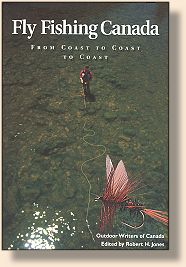Fly-Ins, Part 2
By Dr.Martin Lamont
From Fly Fishing Canada From Coast to Coast, Published
by Johnson Gorman Publishers. We appreciate use permission.
Ensure you have enough food, spare parts, boat props
and fuel. Thorough preparation pays off; alternatively,
a resupply flight is very expensive.
It pays to start off with a group of healthy, low-risk
companions, but a comprehensive first-aid medical kit
and a bush radio are also essential.
Tents should be lightweight for hiking or canoe trips,
but for site-specific summer camps used for prolonged
periods, use quality canvas tents. When camping in
bear country, fortify the cooking tent with "bear boards"
(nailed 4 x 8' plywood sheets), and use all other
recommended bear-avoidance tactics.
Surprisingly, fly-fishing equipment is not very important,
so keep it simple. Limit yourself to pack rods and a
couple of reels, lines, a selection of flies, light-weight
(and reliable) waders, self-inflating personal flotation
devices which are not too bulky and spare waterproof bags
in which to keep a change of clothing and your sleeping bag.
Getting to these last frontiers starts with international
carriers delivering anglers to airports at Winnipeg,
Saskatoon, Vancouver and Whitehorse, with Edmonton
and Yellowknife serving a wider northern distribution.
From these centers, scheduled carriers fly to smaller
towns, most of which have nearby floatplane facilities.
These charter operators provide fly-ins to full-service
lodges, drop-off and pickup services to remote tent camps,
day trips to alpine lakes, lake hopping, and camping and
heli-fishing on some rivers.
Northern wilderness trips are confined to a short season,
mostly July, August and September; however, some western
locations open in the spring.
I will share a few of my experiences, but bear in mind
that there are many more excellent locations.
The Coastal Island and Saltchuck Floatplanes
"Spectacular" describes fly-ins through British Columbia,
there being a great variety of terrain and fish species.
Flights which originate in Vancouver and Victoria connect
with peripheral areas closer to the action, places like
Campbell River, Prince George, Fort St. James, Smithers,
Burns Lake, Nimpo Lake and Fort Nelson.
Small floatplanes are perfect for exploring remote coastal
rivers on the Queen Charlotte Islands, a land of permanently
green trees and undergrowth dripping wet from constant,
moisture-laden weather fronts blowing in from the Pacific
Ocean, where misty landscapes merge with the sky and rich
marine environs embrace the archipelago.
We touched down with a watery swish as the pilot dump-landed
onto a small coastal tarn and then beached. It was only a
short forest hike to reach the open river estuary where
smells of salt and seaweed blended with the cries of gulls.
It was late fall and vast schools of coho were advancing
with the incoming tide, waves of fish pushing upstream.
Coho broke the surface with their backs, and out in the
surf occasional fish hurtled into the air to avoid
pursuing seals.
Our group split up, some to the river, others to the beach.
There was no need for deep wading on the beach; knee depth
was enough to avoid the narrow seaweed line which so
annoyingly fouls leaders and flies. We used intermediate
sinking lines to cast No. 8 flies with silver bodies,
sparse white hair wings and fluorescent green heads.
Fishing was hot - about 20 hook-ups, some bright
silver fish, others with the pinkish purple color of
early ripening fish, all 5 - 15 pound (2 - 7 kg).

In the river, our companions were casting No. 4 Purple
Egg-Sucking Leeches with equal success. Coho after
cartwheeling coho, hard-fighting, were more out of
than in the water. At one point the density of fish
was astonishing; the water went dark as they swam by
the anglers. So many fish, so much fine - a rare utopian
occasion. I stopped fishing, content to sit back and
simply watch the arcing fly rods as others played and
released those wild salmon.
Continued Next Time
Credits: Excerpt from Fly Fishing
Canada written by Outdoor Writers of Canada,
edited by Robert H. Jones, Published by Johnson
Gorman Publishers. Used with permission.
Our Man In Canada Archives
|

